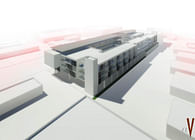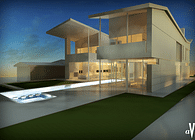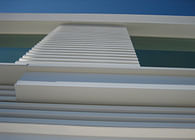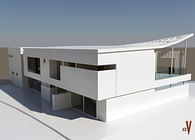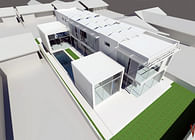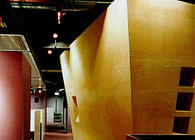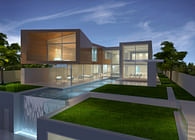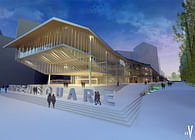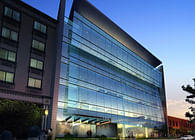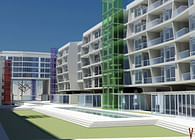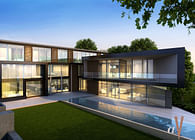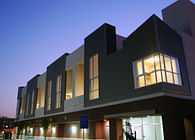
atelier V: architecture (www.atelierv.com) has participated in the International Design Competition for the Design of the Grand Central Mosque of Prishtina in Prishtina, Kosovo. The competition opened in December of 2012 and all entries were submitted by March of 2013. "Our intent in entering International Competitions is two-fold: first, to expand our marketing effort beyond our local comfort zone, and secondly, it gives us an opportunity to test our skills against world class competition which in turn will benefit all our present and future clients." says Mark Vaghei, AIA, atelier V's Design Principal. The competition site is an urban site in the Dardania district of Prishtina. The site is surrounded by 3 and 4 story residential and commercial buildings of 1970 to 2000 era and slopes nearly 5 meters from east to west. "The challenge of this site was to strategically locate the main prayer hall on the major drag with its internal axis facing Mecca while entering it on exactly the opposite side away from the main boulevard" says Mark Vaghei. In the following, a brief background and history of Islam in Kosovo and the current needs for a Grand Mosque as depicted in the competition brief are presented followed by atelier V's competition brief:
BACKGROUND
Islam in Kosovo has a history of over six centuries, now a main part of its cultural identity, with the Islamic architecture as an integral part of it. From the Ottoman Islamic architecture, over the time original features were developed that formed a unique local style on the basis of the Ottoman style, which in the sacral architecture always kept the core components of the Ottoman mosque. From this we may conclude that, the mosque architecture in Kosovo does not start today, on the contrary, it presents a continuity of a long and deep tradition in this place. The Muslim community of the city of Prishtina finds itself in a hard situation due to the lack of praying space and the disproportional mosque coverage between the old and the new part of the city. This situation is a consequence of the city growth during the socialist period where the sacral buildings were not a part of the urban planning agenda. Mosques in Prishtina are mainly located in the old (northern) part of the city and most of them remain from the Ottoman Period. Those are small masjids that have been planned for the neighborhood needs and a bigger one for the Friday prayers,. They are old and have cultural heritage values. Except of some new built mosques, the overall prayer space consists of the old ones which are actively being used by the city's Muslim community. The deficient prayer space has resulted in a trend of building extensions to the existing mosques with the community's intension to gain more space andeven using the public spaces near them especially for the Friday prayers. Hence, considering these growing urgent necessities of the Muslim community in Prishtina, the Islamic Community of the Republic of Kosovo submitted a request to the Assembly of the Municipality of Prishtina for an appropriate location for building a Central Mosque in city in order to fulfill the community's needs. The difficulties finding an appropriate location have been due to the fact of previous urban planning of the city. After the definition of the location from the Municipality of Prishtina, the Islamic Community of the Republic of Kosovo emphasizing the importance of this Mosque as the Central one in the city took the decision of designing it through an International Competition. The consideration of building this Mosque as one with extraordinary importance to the Muslim Community of Kosovo, should serve as a crucial guide in the design process.
HISTORY AND CURRENT SITUATION
The subject of this competition is the focal point of a Muslim's life, the Mosque. The function of the Mosque is in the first place a space to worship Allah (God) in the way that he required to be worshipped. Except the basic function it also has other roles, like social, educational, political etc. On the spiritual dimension the Mosque serves as a guarding tower, an everlasting source of integrity and a place of social, cultural and religious revival. Therefore the mosque is the most valuable institution that could have been ever established. Depending on the location of building, mosques adopted local traditional architectonic features, creating various substyles. This being a virtue of Islam has proved saving the different traditions and culture and not tending to assimilate the people joining Islam. Regardless of the regional building styles, mosques have their unified elements that can be found in all of them. Mosques were always built in the centres of a habitation (town, neighbourhood etc.) where together with other buildings around the urban scheme of the habitat was established. This core of the habitation was organized and made possible by the Waqf institution (a charitable trust) which played a major role in building the Islamic architecture. Since the territory of today's Kosovo was within the Ottoman Empire, the mosques in it belong to the Ottoman and the pre-ottoman or Seljuk style like most mosque architecture in the Balkans. The Seljuk style is characterized by a wooden construction - hipped roof, covered with tiles. The other more advanced mosque style to be found here is the Ottoman style – the so called sultanic mosques covered with domes. These styles are a direct impact from the Ottoman Empire's peak of centralization in the 15th and 16th century. Although the Ottoman building was modified with ethnic motifs by Albanian craftsmen the local characteristics make the regional attributes of the distinct. About the attributes of the local craftsmanship in the very early years of the Ottoman rule in these lands writes the Turkish researcher Prof. Dr. Zeynep AHUNBAY. She writes for example about the small narrow openings below the minaret cone as a local characteristic of the kosovar mosque. While the Dutch researcher Prof. Machiel Kiel describes building of the clock towers near the mosques as a unique creative Albanian characteristic. Inter alia he writes: “This combination of religious and secular, including the ottoman elements and those local and western, have shaped the main part of the bazar and the true core of every Albanian town. The combination of these elements, visually heterogeneous, reflects the real place of Albania in the history as a connecting road between East and West”. As the Ottoman impact was falling in the late 17th and especially in the 19th and 20th century, and Islam was accepted in masses amongst the Albanian population, the impact of the local craftsmanship was growing displaying more the original local architectural features as a Islamic-Albanian style. This style presents a synthesis of ottoman elements digested by the time by the local craftsman and Albanian building tradition. On our onsite researches this was easily noticeable.
atelier V's competition brief:
Our design solution for The Central Mosque of Prishtina is founded in the notion that Prishtina is a bridge between the East and the West.
It is not an entirely Eastern mosque because of Prishtina’s various Western influences. Nor is it a structure modeled after the latest Western design trends because Prishtina has such strong roots in Islamic culture and history-- primarily an Eastern phenomenon. The Central Mosque of Prishtina therefor becomes a unique response to the culture, society and geography at the macro scale as well as the district of Dardania and the city of Prishtina at a more micro scale. The mosque is grand and monumental, yet inviting at a human scale. The grand scale relates to Dardania and Prishtina with a minaret height of 83 meters above Bulevardi I Deshmoreve. The main structure is 39 meters high. This height and scale will assure it a landmark status in a city dominated by low to mid-rise residential structures. The glass enclosed Minaret will be seen from a majority of the city through out the day and night. At night, the glass envelope around the Minaret will project light into the sky, reaching for the God and heavens! At a more human scale, the main prayer hall structure is very approachable. It sits singularly and monumentally detached from other structures in the complex. This allows for a free and unrestricted circulation of large numbers of visitors to move into the open and semi-open upper hayat, continue around the prayer hall and into the main entrance. Walking around the main prayer hall, one can pass underneath the protective glass cube enclosure and touch the stone walls of the hall which are adorned with large scale modern Koranic calligraphy. The circular motion created around the octagonal shape of the prayer hall naturally leads people to the entry point on the opposite side of the Kiblah. The men’s prayer hall is deliberately sunk one level down from the level of Bulvardi I Deshmoreve to allow females to enter the mosque’s Mahfil in a more direct way, a progressive gesture in line with today’s Islam and particular to Kosovo’s position in the Islamic world. Men descend down a grand stair case into an interior portico and enter the men’s prayer hall on the lower level directly opposite of the Kiblah. The lower portico is also directly accessed via the lower Hayat for those men and women who arrive on foot from the western side of the property. The site is planned to step down with the terrain from east to west. Lowering the men’s prayer hall one level has allowed direct access from the lower hayat. The lower hayat which is surrounded by the library, class rooms, restaurant, multi-purpose rooms, and the conference hall will be a place of gathering. During festivals, the lower hayat can be used as additional prayer space. The lower hayat is marked with and oriented by a clock tower, a uniquely Albanian feature which doubles as an elevator shaft for access to the parking below as well as the library and Imam’s apartment above. Similar to the main prayer hall, the concrete clock tower is adorned with verses from the Koran. All of the important functions of the complex, including the main prayer hall, can be easily accessed from the lower hayat. The lower hayat acts as a social gathering space and an organizing design element. In the middle of the lower hayat is a fountain which can be used for ablution during mild weather. The fountain also functions as a skylight to the shops on the level below. The lower hayat can be accessed from the East (upper hayat), North and South (pedestrian path). From the lower hayat, the monumental mass of the mosque can be seen, leaving no doubt as to it’s presence and importance! The main prayer hall structure is derived from two distinct forces of geometry. The first is the direction of the general city grid and the axis of Bulevardi I Deshmoreve, the second is the direction of Kaba. The form starts out as a square--a significant form within Islamic architecture--and turns it’s direction to face Kaba, leaving behind the ghosted form of a cubic glass enclosure. The glass cube allows the mosque to continue to have a dialogue with the city grid. Once the square form is turned, the limitations of the site clip its corners. The form becomes an octagon with the main axis facing Kaba. Juxtaposition of square upon square and each sequential rotational movement form the basis of the geometry of the dome of the main prayer hall. The gaps in this three dimensional juxtaposition become skylights that fill the main prayer hall with a very high quality of light and shadow. The main prayer hall floor is approximately 2,580 square meters. The Mihrab is a direct result of the geometry of the Prayer Hall--a glass wedge which is clearly identifiable from the interior as well as the exterior of the mosque. This glass wedge descends into the lower men’s prayer hall level with back-lit glass. The interior of the prayer hall is monumental and mesmerizing. One can look up at the ceiling and see the beautiful patterns of the beam structure of the dome and hanging pendent lights following the pattern above. The walls are adorned with gold plated calligraphy repeating “In the name of God the merciful and kind.” The floor is a deep red patterned carpet signifying the richness of Allah. The Mahfil or women’s prayer floor is on the main and second gallery levels. The main level is accessed directly from Bulevardi I Deshmoreve and the second level is accessible via two sets of elevators and staircases. These levels look directly upon the men’s prayer and at the Mihrab. On all three levels, the relief calligraphy alternately becomes bookshelves for Korans. The cubic glass enclosure around the main prayer hall has a practical, urban and symbolic significance. From a practical point of view, it protects the main structure from severe winds during the winter months and contains solar cells within it’s glass panels that transform sunlight into electricity. These same panels also feature Koranic verses conveying different messages from afar (“The religion before Allah is Islam”) and close up (“There is no compulsion in religion”) as symbolic representations of Islamic identity. In an urban sense the glass cube follows the city grid and aligns itself with Bulevardi I Deshmoreve. This gives the mosque a proper place within the city fabric while still allowing the structure within to turn towards Kaba. Symbolically, the enveloping glass cube is a metaphore for the Kaba’s cubic structure, protecting the sacred mosque much like a jewel in a jewel box. At night the entire glass cube becomes a digital LED surface glowing and conveying messages at micro and macro scales, acknowledging man’s technological progress in Islam. The areas around the men’s prayer hall are clearly segregated into male and female regions. The men’s and women’s ablution, showers and toilets are in completely separate wings. Women can enter these areas directly without encountering men by using dedicated stairs and elevators from the main level and lower hayat. The Imam’s room is directly behind the Mihrab. A door from the men’s prayer hall gives the Imam direct access to his room. The Imam is also provided an office within the administrative wing, next to the accounting and other related offices. The conference hall (500-person capacity) opens directly into the lower hayat. The conference hall can also be flexibly configured into 2 or 3 separate rooms. The shops in the complex are organized along the Southern pedestrian path, as well as the North and West boundaries of the site. Additional shops are provided in the level below the lower hayat in a bazaar-like configuration. These shops are accessed from a West facing entry and via elevators from the parking below. These elevators also are used to access the prayer hall above, allowing efficient circulation throughout the complex. The provided indoor circulation is convenient for visitors during the cooler winter months, allowing them to access most of the complex while being sheltered from the elements.
“...we are focused on the presence of the main prayer hall within the Prishtina city fabric and signifying its importance as a symbol of progressive Islam.”
It is our strong feeling that due to the importance of the Central Mosque of Prishtina to the community and Kosovo at large, a substantial budget needs to be allocated for the project. Funds need to be allocated carefully to prioritize the various aspects of the structure--particularly the prayer hall. The importance of the main prayer hall structure cannot be over-emphasized. The main prayer hall needs to take funding priority in the project. We are proposing a prayer hall which is grand in scale and truly monumental, deserving of the Islamic Community of Kosovo. The material used in this prayer hall should give it a feeling of permanence, much like the many mosques previously built in the early history of Prishtina. Therefore we have proposed reinforced concrete as the primary structural shell of the building. The concrete will be clad on the exterior and interior with marble slabs and further decorated with gold plating on the cast-in-place wall calligraphy. Additionally, we are proposing a stainless steel space frame structure on the exterior of the prayer hall which supports a glass box enclosure of panels decorated with photo-voltaic cells doubling as Koranic verses. These panels will also act as LED panels during the evening hours to relay symbolic messages to the public at various scales and distances. The cost of the main prayer hall will be appropriate for a structure designed to withstand the test of time and be a valued community institution for decades to come. Our estimate for the price of this structure is approximately 3.500 Euros per square meter. With regard to the prayer hall and the appropriate price point for such a structure, we feel the auxiliary structures of the complex should be approached more economically. This is why we propose a minimal use of expensive materials and methods for the remainder of the complex. This allows for the bulk of the budget to be used on the main prayer hall, thereby reducing the total average cost per square meter of the entire project. Upon a successful result in the competition, we will propose a multi-disciplinary team of architects, engineers, façade specialists, lighting designers, landscape architects, etc. to the project sponsors. The team will be headed by our staff and will draw on the necessary expertise of consultants within Prishtina, within Kosovo, and within the international community if necessary. We expect to establish a work office near the project site in Prishtina and employ local talent to continue the work on the development of the project design. What is provided within the contents of the competition package is only an introductory concept of the project. The concept will be developed further with the input from the sponsors as well as the expert team members. A full cost estimate will be established through 2 or 3 acceptable general contractors/builders. Our team has numerous years of experience in realizing large and complex projects. We feel we can bring our expertise to bear on this important project as well. Overall, it is our opinion that our proposed scheme is a very cost effective and buildable scheme which maximizes the value of the available funds where the project matters most! Which is to say, we are focused on the presence of the main prayer hall within the Prishtina city fabric and signifying its importance as a symbol of progressive Islam.
To see the competition brief and guidelines, please go to: http://cmprcompetition.com/
To see the entire scheme submitted by atelier V: architecture, go to: www.atelierv.com , go to Projects/Religious/Central Mosque of Prishtina
atelier V Credits:
Elise McCurley, 3D artist, Junior Designer
Elisabetta Vito, Model Maker/Intern
Location: Prishtina, Republic of Kosovo
Type: Islamic Mosque complex
Size: 40,520 sqm (436,000 SF) , 7-levels.
Client/Promoter: Islamic Community of the Republic of Kosovo (BIRK)
International Architectural Design Competition.
Competition Jury:
1. Naim Trnava President of the Islamic Community of the Republic of Kosovo
2. Sabri Bajgora Head Imam of the Republic of Kosovo
3. Amir Paic professor of architecture - Head of Architectural Department (IRCICA)
4. Attilio Petruccioli - professor of architecture at Qatar University in Doha, Qatar
5. Ibrahim Numan - professor of architecture at Fatih Sultan Mehmet Vakif University, Istanbul, Turkey
6. Muhamet Morina architect at the Directorate of Urbanism, at the Municipality of Prishtina, Kosovo
7. Jusuf Xhibo architect at the Institute for the Protection of Cultural Monuments in Prizren, Kosovo
UPDATE NEWS:
No Clear Winner (yet) in Kosovo’s Central Mosque of Prishtina Competition
Status: Competition Entry
Location: Prishtina, Kosovo
My Role: Principal Designer
Additional Credits: Elise McCurley
Elisabetta Vito

